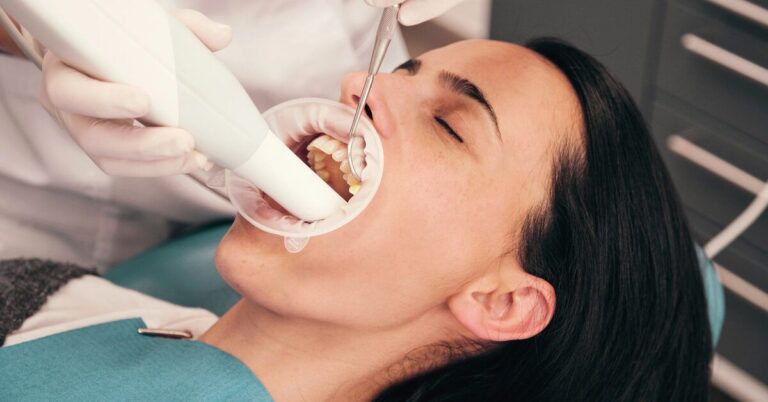Oral hygiene can fight bad breath and prevent gum disease. Therefore, it is important to brush and floss regularly and see a dentist twice a year for regular dental cleanings.
Sometimes, however, a dentist will recommend a deep cleaning of the teeth. Signs that you may need a deep cleaning include bleeding gums, receding gums and loose teeth. Although a deep cleaning—also called periodontal scaling or root planing—is common, it has its risks.
Here’s what you need to know about deep cleaning, including the disadvantages of this procedure.
A deep dental cleaning can remove plaque and tartar build-up from your teeth, reducing gum inflammation and improving gum health.
Plaque is a sticky film that forms on the teeth. It contains bacteria and develops when food particles mix with saliva. You can remove the plaque that builds up on the teeth every day by brushing your teeth.
Brushing, however, does not remove all the plaque between your teeth. The remaining plaque calcifies or hardens, forming a stone.
Plaque or tartar build-up can lead to gum disease. This includes gingivitis, which is inflammation of the gums. If left untreated, gingivitis can develop into periodontitis. This is a serious infection that destroys the bone that supports the teeth.
You may need a deep cleaning if gum disease causes your gums to pull away from your teeth, creating a space more than 5 millimeters (mm) deep.
If gum disease worsens, the space between your gums and teeth may continue to widen. This can weaken the bones that support your teeth, causing loose teeth or tooth loss.
If your dentist recommends a deep cleaning, the benefits of this procedure include:
- stopping the progression of gum disease.
- treating an ongoing infection and promoting healing
- cleaning your teeth above and below the gums
- elimination of bad breath caused by gum disease
- protecting the roots of your teeth
Although deep cleaning can treat gum disease, the procedure has its risks. Disadvantages of deep cleaning include:
- can cause nerve damage
- does not guarantee reattachment of your gums to your teeth
- it can cause your gums to recede
- possible infection if you have a weakened immune system
- pain and tenderness
Pain and tenderness are the most common side effects. The risks of deep cleaning are usually minimal and only last about 5 to 7 days, although for extensive cases, this can extend to a few weeks.
Deep teeth cleaning is different from regular teeth cleanings. Regular cleaning removes plaque and tartar from above the gum line. A deep cleaning, on the other hand, removes plaque and tartar from below the gum line.
Gingivitis causes a gap between your teeth and gums where tartar and plaque can get trapped. Cleaning below the gum line removes this buildup.
Deep cleaning includes scaling the gums and planing the roots
Deep cleanings are usually performed in two or more visits and include gum scaling and root planing. Each visit can last 1 to 2 hours.
A scaling appointment is when your dentist removes plaque and tartar from below the gum line. During a root planing visit, your dentist removes the plaque and tartar that form on the roots of your teeth. This helps reduce the size of the space between your teeth and gums, helping your gums reattach to the teeth.
You may need to take antibiotics
If your immune system is compromised, you may need to take an antibiotic for a few days. This is because there is a risk of infection after the procedure. Additionally, dental deep cleaning can sometimes release bacteria into the bloodstream.
Is deep cleaning painful?
Tooth scaling and root planing may cause some discomfort, so you will receive a topical or local anesthetic to numb your gums.
You can expect some tenderness after your treatment. Your gums may swell and you may have a little bleeding.
How to reduce sensitivity after the procedure
Eating soft foods (yogurt, applesauce, or mashed potatoes) for a few days after the procedure may help reduce sensitivity. You should also avoid extremely hot or cold foods and drinks.
Taking over-the-counter pain relievers such as acetaminophen and ibuprofen can reduce inflammation, as can rinsing with warm salt water.
Brushing and flossing on a regular basis promotes healing and reduces further gum inflammation. Use a soft-bristled toothbrush at least twice a day and floss at least once a day.
The cost of deep cleaning varies depending on the severity of the gum disease or inflammation.
You will likely have two visits, although some people may need up to four visits to completely remove the stone and plaque. During these cleanings, your mouth is considered in quadrants. You can pay $100 or more per quadrant depending on where you live or how much treatment you need.
If you have dental insurance, most plans cover deep cleaning.
Deep cleaning your teeth helps get rid of bad breath and promotes the healing of gum disease. Deep cleansing carries risks, so it’s important to understand any potential complications or side effects.
Although a common, safe procedure, you can expect some tenderness and swelling afterwards. If swelling, bleeding, or pain continues for more than a week after the procedure, see your dentist.


